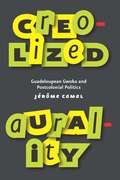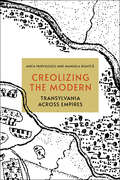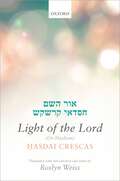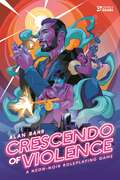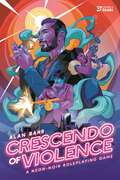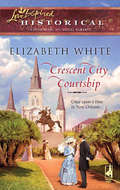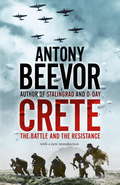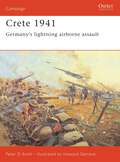- Table View
- List View
Creolized Aurality: Guadeloupean Gwoka and Postcolonial Politics (Chicago Studies in Ethnomusicology)
by Jérôme CamalIn the Caribbean island of Guadeloupe, the complex interplay between anticolonial resistance and accommodation resounds in its music. Guadeloupean gwoka music—a secular, drum-based tradition—captures the entangled histories of French colonization, movements against it, and the uneasy process of the island’s decolonization as an overseas territory of France. In Creolized Aurality, Jérôme Camal demonstrates that musical sounds and practices express the multiple—and often seemingly contradictory—cultural belongings and political longings that characterize postcoloniality. While gwoka has been associated with anti-colonial activism since the 1960s, in more recent years it has provided a platform for a cohort of younger musicians to express pan-Caribbean and diasporic solidarities. This generation of musicians even worked through the French state to gain UNESCO heritage status for their art. These gwoka practices, Camal argues, are “creolized auralities”—expressions of a culture both of and against French coloniality and postcoloniality.
Creolized Aurality: Guadeloupean Gwoka and Postcolonial Politics (Chicago Studies in Ethnomusicology)
by Jérôme CamalIn the Caribbean island of Guadeloupe, the complex interplay between anticolonial resistance and accommodation resounds in its music. Guadeloupean gwoka music—a secular, drum-based tradition—captures the entangled histories of French colonization, movements against it, and the uneasy process of the island’s decolonization as an overseas territory of France. In Creolized Aurality, Jérôme Camal demonstrates that musical sounds and practices express the multiple—and often seemingly contradictory—cultural belongings and political longings that characterize postcoloniality. While gwoka has been associated with anti-colonial activism since the 1960s, in more recent years it has provided a platform for a cohort of younger musicians to express pan-Caribbean and diasporic solidarities. This generation of musicians even worked through the French state to gain UNESCO heritage status for their art. These gwoka practices, Camal argues, are “creolized auralities”—expressions of a culture both of and against French coloniality and postcoloniality.
Creolized Aurality: Guadeloupean Gwoka and Postcolonial Politics (Chicago Studies in Ethnomusicology)
by Jérôme CamalIn the Caribbean island of Guadeloupe, the complex interplay between anticolonial resistance and accommodation resounds in its music. Guadeloupean gwoka music—a secular, drum-based tradition—captures the entangled histories of French colonization, movements against it, and the uneasy process of the island’s decolonization as an overseas territory of France. In Creolized Aurality, Jérôme Camal demonstrates that musical sounds and practices express the multiple—and often seemingly contradictory—cultural belongings and political longings that characterize postcoloniality. While gwoka has been associated with anti-colonial activism since the 1960s, in more recent years it has provided a platform for a cohort of younger musicians to express pan-Caribbean and diasporic solidarities. This generation of musicians even worked through the French state to gain UNESCO heritage status for their art. These gwoka practices, Camal argues, are “creolized auralities”—expressions of a culture both of and against French coloniality and postcoloniality.
Creolized Aurality: Guadeloupean Gwoka and Postcolonial Politics (Chicago Studies in Ethnomusicology)
by Jérôme CamalIn the Caribbean island of Guadeloupe, the complex interplay between anticolonial resistance and accommodation resounds in its music. Guadeloupean gwoka music—a secular, drum-based tradition—captures the entangled histories of French colonization, movements against it, and the uneasy process of the island’s decolonization as an overseas territory of France. In Creolized Aurality, Jérôme Camal demonstrates that musical sounds and practices express the multiple—and often seemingly contradictory—cultural belongings and political longings that characterize postcoloniality. While gwoka has been associated with anti-colonial activism since the 1960s, in more recent years it has provided a platform for a cohort of younger musicians to express pan-Caribbean and diasporic solidarities. This generation of musicians even worked through the French state to gain UNESCO heritage status for their art. These gwoka practices, Camal argues, are “creolized auralities”—expressions of a culture both of and against French coloniality and postcoloniality.
Creolized Aurality: Guadeloupean Gwoka and Postcolonial Politics (Chicago Studies in Ethnomusicology)
by Jérôme CamalIn the Caribbean island of Guadeloupe, the complex interplay between anticolonial resistance and accommodation resounds in its music. Guadeloupean gwoka music—a secular, drum-based tradition—captures the entangled histories of French colonization, movements against it, and the uneasy process of the island’s decolonization as an overseas territory of France. In Creolized Aurality, Jérôme Camal demonstrates that musical sounds and practices express the multiple—and often seemingly contradictory—cultural belongings and political longings that characterize postcoloniality. While gwoka has been associated with anti-colonial activism since the 1960s, in more recent years it has provided a platform for a cohort of younger musicians to express pan-Caribbean and diasporic solidarities. This generation of musicians even worked through the French state to gain UNESCO heritage status for their art. These gwoka practices, Camal argues, are “creolized auralities”—expressions of a culture both of and against French coloniality and postcoloniality.
Creolizing Europe: Legacies and Transformations (Migrations and Identities #6)
by Encarnación Gutiérrez Rodríguez Shirley Anne TateAn Open Access edition of this book is available on the Liverpool University Press website and the OAPEN library.Creolizing Europe critically interrogates creolization as the decolonial, rhizomatic thinking necessary for understanding the cultural and social transformations set in motion through trans/national dislocations. Exploring the usefulness, transferability, and limitations of creolization for thinking post/coloniality, raciality and othering not only as historical legacies but as immanent to and constitutive of European societies, this volume develops an interdisciplinary dialogue between the social sciences and the humanities. It juxtaposes US-UK debates on ‘hybridity’, ‘mixed-race’ and the ‘Black Atlantic’ with Caribbean and Latin American theorizations of cultural mixing in order to engage with Europe as a permanent scene of Édouard Glissant’s creolization. Further, through a comparative methodological angle, the focus on Europe is broadened in order to understand the role of Europe’s colonial past in the shaping of its post/migrant and diasporic present. ‘Europe’ thus becomes an expanded and contested term, unthinkable without reference to its historical legacies and possible futures. While not all the contributions in this volume explicitly address Edouard Glissant’s approach to creolization, they all engage with aspects of his thinking. All of the chapters explore the usefulness, transferability, and limitations of creolization to the European context. As such, this edited collection offers a significant contribution and intervention in the fields of European Studies, Postcolonial Studies, and Cultural Studies on two levels. First, by emphasizing that race and “cultural mixing” are central to any thinking about and theorization on/of Europe, and second, by applying Glissant’s perspective to a variety of empirical work on diasporic spaces, conviviality, citizenship, aesthetics, race, racism, sexuality, gender, cultural representation and memory.
Creolizing the Modern: Transylvania across Empires
by Anca Parvulescu Manuela BoatcăHow are modernity, coloniality, and interimperiality entangled? Bridging the humanities and social sciences, Anca Parvulescu and Manuela Boatcă provide innovative decolonial perspectives that aim to creolize modernity and the modern world-system. Historical Transylvania, at the intersection of the Habsburg Empire, the Ottoman Empire, Austria-Hungary, and Russia, offers the platform for their multi-level reading of the main themes in Liviu Rebreanu's 1920 novel Ion. Topics range from the question of the region's capitalist integration to antisemitism and the enslavement of Roma to multilingualism, gender relations, and religion. Creolizing the Modern develops a comparative method for engaging with areas of the world that have inherited multiple, conflicting imperial and anti-imperial histories.
Crescas (Or Hashem): Translated with introduction and notes
by Roslyn WeissThis volume is the first complete English translation of Hasdai Crescas's Light of the Lord. Light of the Lord is widely acknowledged as a seminal work of medieval Jewish philosophy and second in importance only to Maimonides' Guide of the Perplexed. Crescas takes on not only Maimonides but, through him, Aristotle, and challenges views of physics and metaphysics that had become entrenched in medieval thought. Once the Aristotelian underpinnings of medieval thought are dislodged, Crescas introduces alternative physical views and reinstates the classical Jewish God as a God of love and benefaction rather than a self-intellecting intellect. The end for humankind then is to become attached in love to the God of love through devoted service.
Crescas (Or Hashem): Translated with introduction and notes
by Roslyn WeissThis volume is the first complete English translation of Hasdai Crescas's Light of the Lord. Light of the Lord is widely acknowledged as a seminal work of medieval Jewish philosophy and second in importance only to Maimonides' Guide of the Perplexed. Crescas takes on not only Maimonides but, through him, Aristotle, and challenges views of physics and metaphysics that had become entrenched in medieval thought. Once the Aristotelian underpinnings of medieval thought are dislodged, Crescas introduces alternative physical views and reinstates the classical Jewish God as a God of love and benefaction rather than a self-intellecting intellect. The end for humankind then is to become attached in love to the God of love through devoted service.
Crescendo of Violence: A Neon-Noir Roleplaying Game (Osprey Roleplaying)
by Alan Bahr2093, Neo York. A dystopian technological marvel, where concrete high-rises brim with holographic neon, as gilded mob bosses, flashy CEOs, and famous vid-stars all strive to consolidate their power over the masses. And while the rain reflects the neon, it never washes away the grime and filth of the streets. Welcome to a world of synth-jazz and cybernetics, where the status quo grinds down the hard-working man and vat-grown clone alike. Whether you're the redemption-seeking gangster, the one good cop in a corrupt system, or the gene-modded musician trying to make it big, you'll be trying to get by in a city that just doesn't care.Epic fight scenes take centre stage in this game of stylised, high-octane bloodshed. Jump straight into the action with a unique ruleset designed to deliver a cinematic, neon-noir experience, as the spotlight focuses on the brutal showdowns that will define you – or leave you face-down in the dirt. So get ready to give them hell, as the sultry notes of the saxophone build into a crescendo of violence.
Crescendo of Violence: A Neon-Noir Roleplaying Game (Osprey Roleplaying)
by Alan Bahr2093, Neo York. A dystopian technological marvel, where concrete high-rises brim with holographic neon, as gilded mob bosses, flashy CEOs, and famous vid-stars all strive to consolidate their power over the masses. And while the rain reflects the neon, it never washes away the grime and filth of the streets. Welcome to a world of synth-jazz and cybernetics, where the status quo grinds down the hard-working man and vat-grown clone alike. Whether you're the redemption-seeking gangster, the one good cop in a corrupt system, or the gene-modded musician trying to make it big, you'll be trying to get by in a city that just doesn't care.Epic fight scenes take centre stage in this game of stylised, high-octane bloodshed. Jump straight into the action with a unique ruleset designed to deliver a cinematic, neon-noir experience, as the spotlight focuses on the brutal showdowns that will define you – or leave you face-down in the dirt. So get ready to give them hell, as the sultry notes of the saxophone build into a crescendo of violence.
The Crescent and the Eagle: Ottoman Rule, Islam and the Albanians, 1874-1913 (Library of Ottoman Studies #Vol. 10)
by George GawrychThe Crescent and the Eagle examines from an Ottoman perspective the awakening of Albanian national identity from the end of the 19th century to the outbreak of World War I – a period of intense nationalism in the Balkans. Drawing on Ottoman and European archival material, the book undermines the customary negative stereotypes of Ottoman rule, offering a more nuanced interpretation. Gawrych argues that the Ottoman-Albanian relationship was not a simple adversarial struggle between Turkish rule and Albanian resistance but a complex set of intertwined and sometimes conflicting allegiances and identities.
Crescent City Courtship: The Preacher's Wife Crescent City Courtship (Mills And Boon Historical Ser.)
by Elizabeth WhiteIndulge your fantasies of delicious Regency Rakes, fierce Viking warriors and rugged Highlanders. Be swept away into a world of intense passion, lavish settings and romance that burns brightly through the centuries Abigail Neal dreams of escaping her life in the slums of New Orleans someday.
The Crescent Obscured: The United States and the Muslim World, 1776-1815
by Robert AllisonFrom the beginning of the colonial period to the recent conflicts in the Middle East, encounters with the Muslim world have helped Americans define national identity and purpose. Focusing on America's encounter with the Barbary states of North Africa from 1776 to 1815, Robert Allison traces the perceptions and mis-perceptions of Islam in the American mind as the new nation constructed its ideology and system of government. "A powerful ending that explains how the experience with the Barbary states compelled many Americans to look inward . . . with increasing doubts about the institution of slavery." —David W. Lesch, Middle East Journal "Allison's incisive and informative account of the fledgling republic's encounter with the Muslim world is a revelation with a special pertinence to today's international scene." —Richard W. Bulliet, Journal of Interdisciplinary History "This book should be widely read. . . . Allison's study provides a context for understanding more recent developments, such as America's tendency to demonize figures like Iran's Khumaini, Libya's Qaddafi, and Iraq's Saddam." —Richard M. Eaton, Eighteenth Century Studies
The Crescent Obscured: The United States and the Muslim World, 1776-1815
by Robert AllisonFrom the beginning of the colonial period to the recent conflicts in the Middle East, encounters with the Muslim world have helped Americans define national identity and purpose. Focusing on America's encounter with the Barbary states of North Africa from 1776 to 1815, Robert Allison traces the perceptions and mis-perceptions of Islam in the American mind as the new nation constructed its ideology and system of government. "A powerful ending that explains how the experience with the Barbary states compelled many Americans to look inward . . . with increasing doubts about the institution of slavery." —David W. Lesch, Middle East Journal "Allison's incisive and informative account of the fledgling republic's encounter with the Muslim world is a revelation with a special pertinence to today's international scene." —Richard W. Bulliet, Journal of Interdisciplinary History "This book should be widely read. . . . Allison's study provides a context for understanding more recent developments, such as America's tendency to demonize figures like Iran's Khumaini, Libya's Qaddafi, and Iraq's Saddam." —Richard M. Eaton, Eighteenth Century Studies
The Crescent Obscured: The United States and the Muslim World, 1776-1815
by Robert AllisonFrom the beginning of the colonial period to the recent conflicts in the Middle East, encounters with the Muslim world have helped Americans define national identity and purpose. Focusing on America's encounter with the Barbary states of North Africa from 1776 to 1815, Robert Allison traces the perceptions and mis-perceptions of Islam in the American mind as the new nation constructed its ideology and system of government. "A powerful ending that explains how the experience with the Barbary states compelled many Americans to look inward . . . with increasing doubts about the institution of slavery." —David W. Lesch, Middle East Journal "Allison's incisive and informative account of the fledgling republic's encounter with the Muslim world is a revelation with a special pertinence to today's international scene." —Richard W. Bulliet, Journal of Interdisciplinary History "This book should be widely read. . . . Allison's study provides a context for understanding more recent developments, such as America's tendency to demonize figures like Iran's Khumaini, Libya's Qaddafi, and Iraq's Saddam." —Richard M. Eaton, Eighteenth Century Studies
The Crescent Obscured: The United States and the Muslim World, 1776-1815
by Robert AllisonFrom the beginning of the colonial period to the recent conflicts in the Middle East, encounters with the Muslim world have helped Americans define national identity and purpose. Focusing on America's encounter with the Barbary states of North Africa from 1776 to 1815, Robert Allison traces the perceptions and mis-perceptions of Islam in the American mind as the new nation constructed its ideology and system of government. "A powerful ending that explains how the experience with the Barbary states compelled many Americans to look inward . . . with increasing doubts about the institution of slavery." —David W. Lesch, Middle East Journal "Allison's incisive and informative account of the fledgling republic's encounter with the Muslim world is a revelation with a special pertinence to today's international scene." —Richard W. Bulliet, Journal of Interdisciplinary History "This book should be widely read. . . . Allison's study provides a context for understanding more recent developments, such as America's tendency to demonize figures like Iran's Khumaini, Libya's Qaddafi, and Iraq's Saddam." —Richard M. Eaton, Eighteenth Century Studies
Crescent Remembered: Islam and Nationalism on the Iberian Peninsula (Liverpool Studies in Spanish History)
by Patricia HertelContemporary Spain and Portugal share a historical experience as Iberian states which emerged within the context of al-Andalus. These centuries of Muslim presence in the Middle Ages became a contested heritage during the process of modern nation-building with its varied concepts and constructs of national identities. Politicians, historians and intellectuals debated vigorously the question how the Muslim past could be reconciled with the idea of the Catholic nation. The Crescent Remembered investigates the processes of exclusion and integration of the Islamic past within the national narratives. It analyses discourses of historiography, Arabic studies, mythology, popular culture and colonial policies towards Muslim populations from the 19th century to the dictatorships of Franco and Salazar in the 20th century. In particular, it explores why, despite apparent historical similarities, in Spain and Portugal entirely different strategies and discourses concerning the Islamic past emerged. In the process, it seeks to shed light on the role of the Iberian Peninsula as a crucial European historical "contact zone" with Islam.
Cresheim Farm: An American History of Conquest, Privilege and Struggles for Freedom and Equality (Sociology Re-Wired)
by Antje Ulrike MattheusThis book is a work of political archaeology. It focuses on the people and events at a particular colonial farm in Germantown, Pennsylvania; their stories provide a micro and macro view of economic, social, demographic, and agro-ecological change. Cresheim Farm shows how one mostly unknown but strategically placed piece of land—home to an extraordinary array of people, including early anti-slavery and anti-Nazi activists, the first woman editor of the Saturday Evening Post and a robber baron—can tell, affect and reflect the history of a nation. The writing is historically grounded and academic, future-oriented, deeply researched, and immediate. Cresheim Farm serves as a lens through which to observe and understand social forces, such as the launching point of freedom and democracy movements, white privilege, slavery, and genocidal westward expansion. The past lives on in all of us.
Cresheim Farm: An American History of Conquest, Privilege and Struggles for Freedom and Equality (Sociology Re-Wired)
by Antje Ulrike MattheusThis book is a work of political archaeology. It focuses on the people and events at a particular colonial farm in Germantown, Pennsylvania; their stories provide a micro and macro view of economic, social, demographic, and agro-ecological change. Cresheim Farm shows how one mostly unknown but strategically placed piece of land—home to an extraordinary array of people, including early anti-slavery and anti-Nazi activists, the first woman editor of the Saturday Evening Post and a robber baron—can tell, affect and reflect the history of a nation. The writing is historically grounded and academic, future-oriented, deeply researched, and immediate. Cresheim Farm serves as a lens through which to observe and understand social forces, such as the launching point of freedom and democracy movements, white privilege, slavery, and genocidal westward expansion. The past lives on in all of us.
A Cretan Healer's Handbook in the Byzantine Tradition: Text, Translation and Commentary (Medicine in the Medieval Mediterranean #3)
by Patricia Ann ClarkIn 1930 the Cretan healer Nikolaos Konstantinos Theodorakis of Meronas re-copied a notebook containing medical lore passed down through his family over generations. The present volume offers an edition of this notebook together with an English translation, the first of its kind. It belongs to the genre of iatrosophia, practical handbooks dating mainly to the 17th to 19th centuries which compiled healing wisdom, along with snippets of agricultural, meteorological and veterinary advice, and admixtures of religion, astrology and magic. Both fascinating and of critical importance, iatrosophia allow glimpses of classical and Byzantine medical sources and illustrate the vitality and resilience of Greek traditional medical and botanical knowledge. From years spent exploring local healing customs in Crete's Amari region, Patricia Clark is able to present Theodorakis' iatrosophion against a rich historical, geographical and social background. Introductory essays and explanatory notes to the translation give context to the iatrosophion and provide the specialized information necessary for a good understanding of the text. The abundant materia medica of the notebook is treated in a substantial appendix. Each animal, mineral, plant or product is provided with an overview of its various names through the millennia. Such entries are not only a key to understanding the Greek medical legacy, but also a vivid illustration of its usage from antiquity to the present day.
A Cretan Healer's Handbook in the Byzantine Tradition: Text, Translation and Commentary (Medicine in the Medieval Mediterranean #3)
by Patricia Ann ClarkIn 1930 the Cretan healer Nikolaos Konstantinos Theodorakis of Meronas re-copied a notebook containing medical lore passed down through his family over generations. The present volume offers an edition of this notebook together with an English translation, the first of its kind. It belongs to the genre of iatrosophia, practical handbooks dating mainly to the 17th to 19th centuries which compiled healing wisdom, along with snippets of agricultural, meteorological and veterinary advice, and admixtures of religion, astrology and magic. Both fascinating and of critical importance, iatrosophia allow glimpses of classical and Byzantine medical sources and illustrate the vitality and resilience of Greek traditional medical and botanical knowledge. From years spent exploring local healing customs in Crete's Amari region, Patricia Clark is able to present Theodorakis' iatrosophion against a rich historical, geographical and social background. Introductory essays and explanatory notes to the translation give context to the iatrosophion and provide the specialized information necessary for a good understanding of the text. The abundant materia medica of the notebook is treated in a substantial appendix. Each animal, mineral, plant or product is provided with an overview of its various names through the millennia. Such entries are not only a key to understanding the Greek medical legacy, but also a vivid illustration of its usage from antiquity to the present day.
Crete: The Battle and the Resistance (History And Warfare Ser.)
by Antony BeevorAcclaimed historian and best-selling author Antony Beevor vividly brings to life the epic struggles that took place in Second World War Crete - reissued with a new introduction.'The best book we have got on Crete' ObserverThe Germans expected their airborne attack on Crete in 1941 - a unique event in the history of warfare - to be a textbook victory based on tactical surprise. They had no idea that the British, using Ultra intercepts, knew their plans and had laid a carefully-planned trap. It should have been the first German defeat of the war, but a fatal misunderstanding turned the battle round. Nor did the conflict end there. Ferocious Cretan freedom fighters mounted a heroic resistance, aided by a dramatic cast of British officers from Special Operations Executive.
Crete 1941: Germany’s lightning airborne assault (Campaign)
by Howard Gerrard Peter AntillOperation Mercury, the German airborne assault on the island of Crete in May 1941, was the first strategic use of airborne forces in history. The assault began on 20 May, with landings near the island's key airports, and reinforcements the next day allowed the German forces to capture one end of the runway at Maleme. By 24 May, the Germans were being reinforced by air on a huge scale and on 1 June Crete surrendered. This book describes how desperately close the battle had been and explains how German losses so shocked the Führer that he never again authorised a major airborne operation.
Crete 1941: Germany’s lightning airborne assault (Campaign #147)
by Howard Gerrard Peter AntillOperation Mercury, the German airborne assault on the island of Crete in May 1941, was the first strategic use of airborne forces in history. The assault began on 20 May, with landings near the island's key airports, and reinforcements the next day allowed the German forces to capture one end of the runway at Maleme. By 24 May, the Germans were being reinforced by air on a huge scale and on 1 June Crete surrendered. This book describes how desperately close the battle had been and explains how German losses so shocked the Führer that he never again authorised a major airborne operation.
